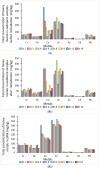Metal Exposure, Bioaccumulation, and Toxicity Assessment in Sediments from the St. Lawrence River Before and After Remediation Using a Resuspension Technique
- PMID: 40559906
- PMCID: PMC12197031
- DOI: 10.3390/toxics13060432
Metal Exposure, Bioaccumulation, and Toxicity Assessment in Sediments from the St. Lawrence River Before and After Remediation Using a Resuspension Technique
Abstract
This study, using Hyalella azteca and Chironomus riparius, evaluated the effects of exposure to heavy metal-contaminated sediments collected from the study area under three conditions: before remediation, after remediation, and suspended particulate matter (SPM). The selected toxicity tests allowed for the evaluation of biological responses across varying concentrations of heavy metals. Statistical analysis revealed no significant differences in survival or growth between sediment-exposed organisms and controls for either species. In addition, bioaccumulation of Cr, Ni, Cu, Zn, As, Cd, and Pb in both organisms was assessed and compared among the sediment conditions and the control. No statistically significant differences in tissue metal concentrations were found between organisms exposed to sediments from the study area and those in control conditions. Sequential extraction analysis indicated that a substantial proportion of metals in the sediments were bound in stable, non-bioavailable forms. These findings are consistent with the observed biological responses, as low levels of bioavailable metals corresponded with the absence of toxic effects. Together, the data confirm that the sediments, regardless of remediation stage or particle fraction, posed no significant biological risk under the conditions tested.
Keywords: Chironomus riparius; Hyalella azteca; bioaccumulation; heavy metals; toxicity.
Conflict of interest statement
The authors declare no conflicts of interest.
Figures








Similar articles
-
Does Augmenting Irradiated Autografts With Free Vascularized Fibula Graft in Patients With Bone Loss From a Malignant Tumor Achieve Union, Function, and Complication Rate Comparably to Patients Without Bone Loss and Augmentation When Reconstructing Intercalary Resections in the Lower Extremity?Clin Orthop Relat Res. 2025 Jun 26. doi: 10.1097/CORR.0000000000003599. Online ahead of print. Clin Orthop Relat Res. 2025. PMID: 40569278
-
Intravenous magnesium sulphate and sotalol for prevention of atrial fibrillation after coronary artery bypass surgery: a systematic review and economic evaluation.Health Technol Assess. 2008 Jun;12(28):iii-iv, ix-95. doi: 10.3310/hta12280. Health Technol Assess. 2008. PMID: 18547499
-
Systemic pharmacological treatments for chronic plaque psoriasis: a network meta-analysis.Cochrane Database Syst Rev. 2021 Apr 19;4(4):CD011535. doi: 10.1002/14651858.CD011535.pub4. Cochrane Database Syst Rev. 2021. Update in: Cochrane Database Syst Rev. 2022 May 23;5:CD011535. doi: 10.1002/14651858.CD011535.pub5. PMID: 33871055 Free PMC article. Updated.
-
Antiretrovirals for reducing the risk of mother-to-child transmission of HIV infection.Cochrane Database Syst Rev. 2011 Jul 6;(7):CD003510. doi: 10.1002/14651858.CD003510.pub3. Cochrane Database Syst Rev. 2011. PMID: 21735394
-
Antiretrovirals for reducing the risk of mother-to-child transmission of HIV infection.Cochrane Database Syst Rev. 2007 Jan 24;(1):CD003510. doi: 10.1002/14651858.CD003510.pub2. Cochrane Database Syst Rev. 2007. Update in: Cochrane Database Syst Rev. 2011 Jul 06;(7):CD003510. doi: 10.1002/14651858.CD003510.pub3. PMID: 17253490 Updated.
References
-
- Löser B.C., Zehnsdorf A., Görsch K., Seidel H. Bioleaching of Heavy Metal Polluted Sediment: Influence of Temperature and Oxygen (Part 1) Eng. Life Sci. 2006;6:355–363. doi: 10.1002/elsc.200520141. - DOI
-
- Wang Y., Yang L., Kong L., Liu E., Wang L., Zhu J. Spatial distribution, ecological risk assessment and source identification for heavy metals in surface sediments from Dongping Lake, Shandong, East China. Catena. 2015;125:200–205. doi: 10.1016/j.catena.2014.10.023. - DOI
-
- Hosono T., Su C.-C., Delinom R., Umezawa Y., Toyota T., Kaneko S., Taniguchi M. Decline in heavy metal contamination in marine sediments in Jakarta Bay, Indonesia due to increasing environmental regulations. Estuar. Coast. Shelf Sci. 2011;92:297–306. doi: 10.1016/j.ecss.2011.01.010. - DOI
Grants and funding
LinkOut - more resources
Full Text Sources
Research Materials

